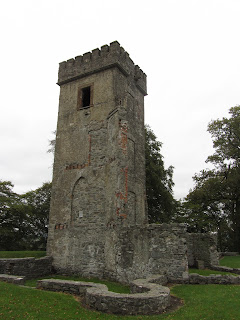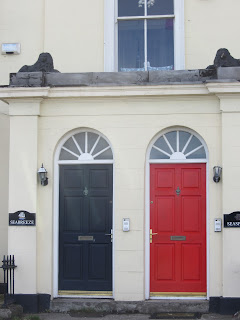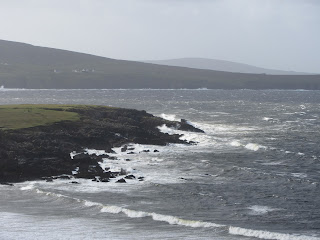Friday, 30 September 2011
The Irony of the Conflict in the North
There was a man named Nolan from Bally-binaby, a village square on the border between the Republic of Ireland and Northern Ireland, of the British Empire. One side of the town is in Free Ireland, and the other is in the Province of Occupied Ulster. Nolan lived in the Republic's side of the town, the local pub sat right on the line, and the village constable lived and worked on the British side of town, so he was part of the Ulster Constabulary Department. Now this man named Nolan was in the IRA in the 1970s during the early part of the Troubles, he was caught smuggling weapons into Northern Ireland, and held in jail as a political prisoner for six months in Belfast. He was eventually released, but under the restrictions that he would never cross the border into Northern Ireland again, under threat of further, more extensive incarceration if he was caught doing so. The local constable of Bally-binaby, was therefore assigned to assure he stayed on the Republic's side of the village, so for the next twenty years, every time the Sinn Feiner Nolan wanted to go to the pub, he had to call up his good friend, the constable, and let him know he was going down for a pint, and could the constable come down to monitor that he did not cross over to the side of the bar belonging to the British Empire. And so, every evening after dinner, the two good friends would meet down to the pub; Nolan sitting at the northernmost bar stool of the Irish Republic, and the constable sitting at the southernmost bar stool belonging to the British Empire, and they would drink their Guinness and Tennants together.
County Down- Warrenpoint
Along this road, running along the river separating Northern Ireland from the Republic, on the 27th of August, 1979, a British Army convoy was ambushed by a guerilla attack of the IRA, while headed into the town of Warrenpoint, down towards the coast. As the lorry loads of British soldiers drove past a point in the road, a bomb was detonated by the IRA, destroying the one truck and pinning down the convoy. After a half hour when the troops were subjected to sniper fire, a chopper arrived with reinforcements and as these reinforcements were setting up a command post at a nearby gatehouse, a second bomb was detonated where the IRA had accurately predicted the reinforcements would be landing, killing twelve more British. In all, 18 British soldiers were killed in this attack, and the IRA column escaped unscathed. It goes down in the late history of The Troubles as being one of the most successful IRA ambushes, and while we were visiting this site, we were guided by Jim McAlistair, a reformed Sinn Feiner from South Armagh with IRA ties, who would have known the column of IRA volunteers who carried out this act.
View of County Down from the Cooley Mountains
One of the branches of Nelson ancestry, the McConnells, originally came from Saintfield, in County Down, in the late 1700's.
The Borderlands
The Round Hill-Fort of Cu Chulainn:
This ancient earthen fort, dating back about 2,000 years, is the alleged fort of Cu Chulainn, a famous warrior from Celtic mythology who is known as the Defender of Ulster. It is located in the far northern portion of County Louth, in the Cooley Mountains of the borderlands, and archeologically, is believed to be the ruins of a fortified corral, for guarding the local Celtic tribe's cattle against raids from neighboring war bands. This ties into the legend of Cu Chulainn, whose most famous act in Celtic mythology is when he defended the Brown Bull of Ulster against the invading army of Queen Meadb of Connacht in the Celtic Epic "The Cattle Raid of Cooley."
The Battle of Moyry Pass- The Gap of the North:
From 1594-1603, the Gaelic Irish of Ulster led by Hugh O'Neill, the Earl of Tyrone, fought what came to be known as the Nine Years War against the English rule in Ireland. In 1600, an English Army under Lord Mountjoy marched north from Dublin to crush this rebellion in the North, but they were held up at the Gap of the North, in the Cooley Mountains along the border of County Armagh and County Louth, where Hugh O'Neill had set up a defensive position in Moyry Pass. Initially repulsed by O'Neill's forces, the English under Mountjoy continued to assault the Gap over about a two week period. After two weeks of continuous attack, the Ulster Irish were forced to withdraw from the pass, thus letting in the invading English Army, which set upon a policy of scorched earth tactics, to bring the rebellion to its knees, burning farms and fields as they went. Three years later, O'Neill and his forces were finally forced to surrender, and control of Northern Ireland has been yielded to the British ever since. Mounjoy Castle, still standing in the Gap of th North today, is a reminder of the initial occupation following the battle, and a lasting legacy of English rule in Ulster.
Thursday, 29 September 2011
Into the North!
I am currently in Northern Ireland for the next couple weeks, and I am afraid that my blogs wont be as frequent as they were while I was in the Republic, as internet access is not as readily available and we'll be very busy while we are here. Its already been a busy couple of days en route to Belfast. Two days ago, we boarded the train for Dundalk, on the border of the Republic of Ireland and the North, which still remains as part of the United Kingdom. From there, we took a bus along the border, into South Armagh, where we stayed at the foot of Cuchulainn's Mountain in a hostel. The following day, yesterday, we spent the morning hiking the Ring of Gullion, and then proceeded on to Armagh city, where we visited the Cathedrals of St Patrick and the tomb of Brian Boru, last High King of Ireland. We then continued on to Belfast City, where we got settled in to dorms late last night, and attended classes today at Queen's University. Tomorrow is another day of intensive classes around "The Troubles" and after that, we'll have the weekend to explore and experience Belfast hands-on. I will post pictures and more blogs as soon as I can, so stay tuned!
Saturday, 24 September 2011
A Day in the Life...
Today, I have spent the morning and a good part of the afternoon with my host-father "Big Bill" O'Dea. We got up early this morning to go down and dig for razor-clams along the beach, and fish for crabs. We caught a nice big crab and found a few clams. After that, we came back for breakfast and tea, we had white pudding, eggs and smoked salmon on toast. We then drove down to Powerscourt Estate- the estate of Lord Slazenger, of tennis and golf ball fame. We went mushroom hunting in the woodlands around the estate, unbeknownst to Lord Slazenger (mushroom poaching, I believe would be the appropriate term). We found a whole basket-full of edible mushrooms. Then, on the way home, we stopped in Dalkey for a pint at the Queen's Inn and to shop through the open air market, where we bought some kidneys from the butcher. When we got home this afternoon, we cooked the clams for a late lunch, and tonight we are having Steak and Kidney Pie with wild mushrooms and cream of crab soup- but first, its time for a swim off the Forty-Foot after the tide goes out!
The Forty Foot swimming point
Mushroom Poaching
"Chicken of the Forest"
Powerscourt Estates
The Queen's Inn- est. 1745
One of the best pubs in Dalkey
Tonight's Side Dish
Our Findings
Fresh Scones for Afternoon Tea
Thursday, 22 September 2011
As Requested by Uncle John- Architecture:
Uncle John wanted to make sure that I appreciated the vernacular architecture while I was in Ireland, so I have just included a few examples of different styles of Irish architecture.
Seaside in Dun Laoghaire
Inner City Dublin
Pub Architecture- Temple Bar District
Molly Malone
"In Dublin's fair city
Where the girls are so pretty,
I first set my eyes on sweet Molly Malone,
As she pushed her wheel-barrow,
Through streets broad and narrow,
Crying: 'Cockles and mussels, alive, alive-oh!'
'Alive, alive-oh, alive alive-oh,'
Crying 'Cockles and mussels, alive, alive-oh.'
She was a fishmonger,
And sure 'twas no wonder,
For so were her father and mother before,
And they pushed their wheelbarrow,
Through streets broad and narrow,
Crying 'Cockles and mussels, alive, alive-oh!'
'Alive, alive-oh, alive alive-oh,'
Crying 'Cockles and mussels, alive, alive-oh.'
She caught her a fever
And no one could save her
And that was the end of sweet Molly Malone
But her ghost wheels the barrow
Through streets broad and narrow
Crying 'Cockles, and mussels, alive, alive-oh!'
'Alive, alive-oh, alive alive-oh,'
Crying 'Cockles and mussels, alive, alive-oh.'
This statue, of the legendary Molly Malone, sits along Grafton Street, in Dublin. Dubliners jokingly call it the "Tart with the Cart."
A Full Irish Breakfast
Sauteed Mushrooms, Toasted Soda Bread, Roasted Tomato, White Pudding, Black Blood Pudding, Sausage, Fried Eggs, Rashers, and Tea.... Lots of Tea.
Sunday, 18 September 2011
Stingy Protestants
Every time my host-mother, Freda O'Dea, wants to say something is cheap or weak, she uses the term "protestant" in front of it. I've also heard other people, including our professors and lectures, use the term to describe something stingy or weak.
Example:
This morning, around the breakfast table, we were trying some jam that she bought at the farmer's market yesterday. It didn't have many whole berries in it, she pointed out, and was mostly sugar and juice, and so she said it was "pure protestant-fit jam, the woman being too tightfisted to put proper berries in it." When her sons make the tea too weak, she calls them protestants too, telling them not to be "stingy scotts about the tea."
Example:
This morning, around the breakfast table, we were trying some jam that she bought at the farmer's market yesterday. It didn't have many whole berries in it, she pointed out, and was mostly sugar and juice, and so she said it was "pure protestant-fit jam, the woman being too tightfisted to put proper berries in it." When her sons make the tea too weak, she calls them protestants too, telling them not to be "stingy scotts about the tea."
An Irish Remedy:
So this morning while we were eating our breakfast of rashers, eggs tea and pudding, one of the neighborhood women, who lives in Kilcolman Court with the O'Deas, came by looking for advice. Her baby was sick with the Croup and she wanted to know what to give her, so Mrs. O'Dea put on her apron, went to the larder, and brought out a bottle of Guinness. She mixed some of it with milk, butter and sugar and heated it on the stove. She then put it in the woman's baby bottle and told her to feed the baby that for the day, and that would clear up the Croup soon. After I watched all this in astonishment, she laughed and explained that when she was young, in the country, that's what her mother would feed them every time they got sick and it was a sure cure. "After all," she said, in all seriousness, "its not healthy to feed a child whiskey for their ailments until they're at least twelve. Guinness works best for the younger ones."
Saturday, 17 September 2011
The Cliffs of Erris
On Tuesday, we went as a group on a 7 mile hike along the Sea Cliffs of Erris. It was by far the one of the biggest highlights of my trip thus far. The local lighthouse keeper's son was our guide, a twenty five year old named Simon who's studying in Galway to be a marine biologist. The views were incredible, but even more than that was the wind. Benwee Head, across which we were hiking, sustains gale-force winds for 340 days out of every year- on average, and the swells would be equal to a Category 1 hurricane for most of the year. It is one of the stormiest and roughest coastlines in the world, due to its location; every storm, hurricane, and gale coming up from the Gulf Stream sweeps across the Atlantic and clips the island of Ireland right in that corner, making it comparable in tempest to Cape Horn or the Cape of Good Hope. The day we were hiking along the cliffs, it was relatively sunny, but the wind was blowing at 75 knots and the waves were 35-40 feet swells against the rocks. It was incredible, I have never felt wind like that, and we all blew over several times each during the course of the hike. Regardless, it was some of the most beautiful scenery I have ever experienced!
An Bhinn Bhui (Benwee Head)
Broadhaven Bay
The Sea Cliffs of Erris
The Stags of Broadhaven
The Village of Cúnga Fheichín (Cong)
Cong is the small village in which Oscar Wilde's father lived and where John Ford shot his classic "The Quiet Man," with Maureen O'Hara and John Wayne. Much of the town is still the same as it was during the filming of the movie, and a picturesque place. Some people have criticized the film for idealizing the Irish rural way of life, but from all I experienced this past week in the West of Ireland, in the rural areas, it seems to be dead on. It really is that friendly and quaint. Its an enchanting place and culture.
The Quiet Man's Cottage
Downtown Cong
The bridge John Wayne and Maureen O'Hara bike across
Back from Mayo
My week trip to County Mayo, in the extreme northwest of the country, was absolutely incredible! The people of the rural west of Ireland are the epitome of hospitality and friendliness. Every interaction out there was like a scene out of The Quiet Man. We stayed in Kilcommon Family Hostel, run by a German lady named Betty, with a turf fire in the hearth and fresh food every day. When one of the local farmer's wives found out that ten Americans were staying up the road from her, she rode her bicycle up to drop off a whole basket of fresh baked scones for our afternoon tea. The following night, a local fisherman came for dinner with us and brought a fresh caught Atlantic salmon to eat. The one night, in the local pub- McGrath's- we were sitting at a table, and a local came in with his Irish flute. The bar tender brought down his own fiddle and the two of them played and sang some Irish songs for us, around the turf fire. We all felt so welcome, it was unbelievable. Like something out of a dream.
Kilcommon Hostel
Turf Fire
McGrath's
The County Flag of Mayo
Croagh Padraig- from a distance
Croagh Patrick, from Westport.
Croagh Padraic- St Patrick's Mountain. According to legend, this is the site where St Patrick climbed and fasted for 40 days, tormented by the paganism of Connaught. After 40 days, he challenged the Druidic priests with his faith. He rang a silver Eucharist bell from the summit and threw it over the edge. In so doing, he cast all the snakes from the island, proving the power of his new Christian religion to the people of the west. After completing this feat, he constructed a chapel on the summit to commemorate the spiritual victory.
Subscribe to:
Posts (Atom)

















































